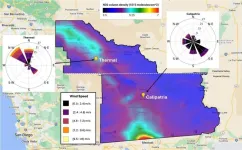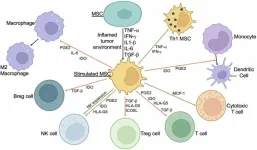How the speed of viral spread can be estimated by the analysis of genomic sequences
Simulated outbreaks demonstrate how evolutionary approaches can estimate the speed of viral spreads
2024-12-03
(Press-News.org) Evaluating the speed at which viruses spread and transmit across host populations is critical to mitigating disease outbreaks. A study published December 3rd in PLOS Biology by Simon Dellicour at the University of Brussels (ULB), Belgium, and colleagues evaluate the performance of statistics measuring how viruses move across space and time in infected populations.
Genomic sequencing allows epidemiologists to examine the evolutionary history of pathogenic outbreaks and track the spatial movement of an outbreak. However, the sampling intensity of genomic sequences can potentially impact the accuracy of dispersal insights gained through these evolutionary approaches. In order to assess the impact of the sampling size, researchers simulated the spread of several pathogens to evaluate three dispersal metrics estimated from the analysis of viral genomes: a lineage dispersal velocity (the speed at which lineages spread), a diffusion coefficient (how fast lineages invade space), and an isolation-by-distance signal (how genomic sequences of a population become less similar over geographic distance) metric.
The researchers found that diffusion coefficient and isolation-by-distance signal metrics were least impacted by sample size/intensity. After using these metrics to compare the dispersal pattern and capacity of various viruses spreading in animal populations, they also discovered the extent to which the speed and distance of viral spread reflects the dispersal capacity of the infected host animal, but may also be influenced by human interference, such as the animal trade. The study does have limitations; for example, the simulation framework did not involve the generation of actual genomic sequences due to limited time and resources.
According to the authors, “Overall, our study provides key recommendations for the use of lineage dispersal metrics to consider in future studies and illustrates their application to compare the spread of viruses in various settings.”
The authors add, “In this study, we evaluate the performance of various metrics estimated from evolutionary trees to quantify the dispersal capacity of viruses in the wild. We then use the most performant metrics to compare the dispersal pattern of various viruses spreading in animal populations, which reveals a broad range of diffusion velocities mostly reflecting the dispersal capacity of the main infected host species but also, in some cases, the likely signature of rapid and/or long-distance dispersal events driven by human-mediated movements through animal trade.”
#####
In your coverage, please use this URL to provide access to the freely available paper in PLOS Biology: http://journals.plos.org/plosbiology/article?id=10.1371/journal.pbio.3002914
Citation: Dellicour S, Bastide P, Rocu P, Fargette D, Hardy OJ, Suchard MA, et al. (2024) How fast are viruses spreading in the wild? PLoS Biol 22(12): e3002914. https://doi.org/10.1371/journal.pbio.3002914
Author Countries: Belgium, France, United States
Funding: see manuscript
END
ELSE PRESS RELEASES FROM THIS DATE:
2024-12-03
Baltimore, Maryland (Dec. 3, 2024) — The Lieber Institute for Brain Development has been selected as a winner of the 2024 Amazon Web Services (AWS) IMAGINE Grant, a public grant opportunity open to registered charities in the United Kingdom and Ireland and registered 501(c) nonprofit organizations in the United States who are using technology to solve the world’s most pressing challenges. The Lieber Institute, located on the Johns Hopkins medical campus in Baltimore, will use the grant to develop a new generative AI tool to find new, more effective treatments for mental illnesses including schizophrenia.
Now ...
2024-12-03
At least one-quarter of all nitrogen oxide (NOx) emissions in California’s Salton Sea air basin come from soil, according to a study from the University of California, Davis.
Using isotopic analysis, the study found that annual total soil emissions for the basin were about 11 tons per day on average, which is 10 times larger than the state’s current inventory for soil NOx emissions in the region. The work was published in the Nature journal Scientific Reports.
The study highlights the need to ...
2024-12-03
Democracy is in crisis. Many people are losing confidence in political parties and parliaments and their ability to solve pressing social problems in the long term. Recent studies by the University of Stuttgart indicate that addressing doubts about the democratic system does not necessarily require resorting to the election of an autocratic head of state. Rather, more direct political participation could revitalize and legitimize democracy - provided that innovative participatory formats are intelligently linked to the work of representative institutions.
“Many people consider representative politics to be tiring ...
2024-12-03
Toronto, ON – Transgender and gender-diverse preteens are about 15% less physically active than their cisgender peers, new research finds.
Transgender 11-12 year-olds take, on average, 1,394 fewer steps per day compared to cisgender adolescents, a difference that equates to about 12% of the daily physical activity recommended for adolescents. The study was published in Annals of Epidemiology.
“Transgender adolescents may experience stigma and discrimination that discourage their participation in team sports or physical activity,” ...
2024-12-03
In late 2022, OpenAI released ChatGPT, an artificial intelligence (AI) chatbot able to generate conversational answers and analyses, as well as images, in response to user questions and prompts. This generative AI was built with computational procedures, such as large language models, that train on vast bodies of human-created and curated data, including scientific literature. Since then, the worry that AI may someday outsmart humans has grown more widespread.
In a new collection of essays, leading ...
2024-12-03
Physicists are getting closer to controlling single-molecule chemical reactions – could this shape the future of pharmaceutical research?Controlling matter at the atomic level has taken a major step forward, thanks to groundbreaking nanotechnology research by an international team of scientists led by physicists at the University of Bath.
This advancement has profound implications for fundamental scientific understanding. It is also likely to have important practical applications, such as transforming the way researchers develop new medications.
Controlling single-outcome single-molecule reactions ...
2024-12-03
“MSCs hold great promise as a therapeutic tool in cancer immunotherapy due to their immunomodulatory properties, tumor-homing abilities, and potential as carriers for delivering therapeutic agents.”
BUFFALO, NY – December 3, 2024 – A new review was published in Oncotarget’s Volume 15 on November 22, 2024, entitled “Mesenchymal stem cells – the secret agents of cancer immunotherapy: Promises, challenges, and surprising twists.”
Authored by Theia Minev, Shani Balbuena, Jaya Mini Gill, ...
2024-12-03
About The Study: In this cohort study of 1,600 emergency medicine patient medical records, large language model (LLM)-generated emergency medicine-to-inpatient handoff notes were determined superior compared with physician-written summaries via conventional automated evaluation methods, but marginally inferior in usefulness and safety via a novel evaluation framework. This study suggests the importance of a physician-in-loop implementation design for this model and demonstrates an effective strategy to measure pre-implementation patient safety of LLM models.
Corresponding ...
2024-12-03
Patients with frontotemporal dementia often lack the ability to empathize. A study at Karolinska Institutet has now shown that these patients do not show the same brain activity as healthy individuals when they witness the pain of others, a finding that it is hoped will increase understanding of this specific dementia disease.
Around 25 000 Swedes are affected by dementia every year. Of these, about three percent are diagnosed with frontotemporal dementia. The disease is difficult to diagnose, but one of its characteristics is that sufferers lose the ability to empathize, which can lead to problems for them, and not least ...
2024-12-03
CAMBRIDGE, MA -- Gastric balloons — silicone balloons filled with air or saline and placed in the stomach — can help people lose weight by making them feel too full to overeat. However, this effect eventually can wear off as the stomach becomes used to the sensation of fullness.
To overcome that limitation, MIT engineers have designed a new type of gastric balloon that can be inflated and deflated as needed. In an animal study, they showed that inflating the balloon before a meal caused the animals to reduce their food intake by 60 percent.
This type of intervention ...
LAST 30 PRESS RELEASES:
[Press-News.org] How the speed of viral spread can be estimated by the analysis of genomic sequences
Simulated outbreaks demonstrate how evolutionary approaches can estimate the speed of viral spreads




